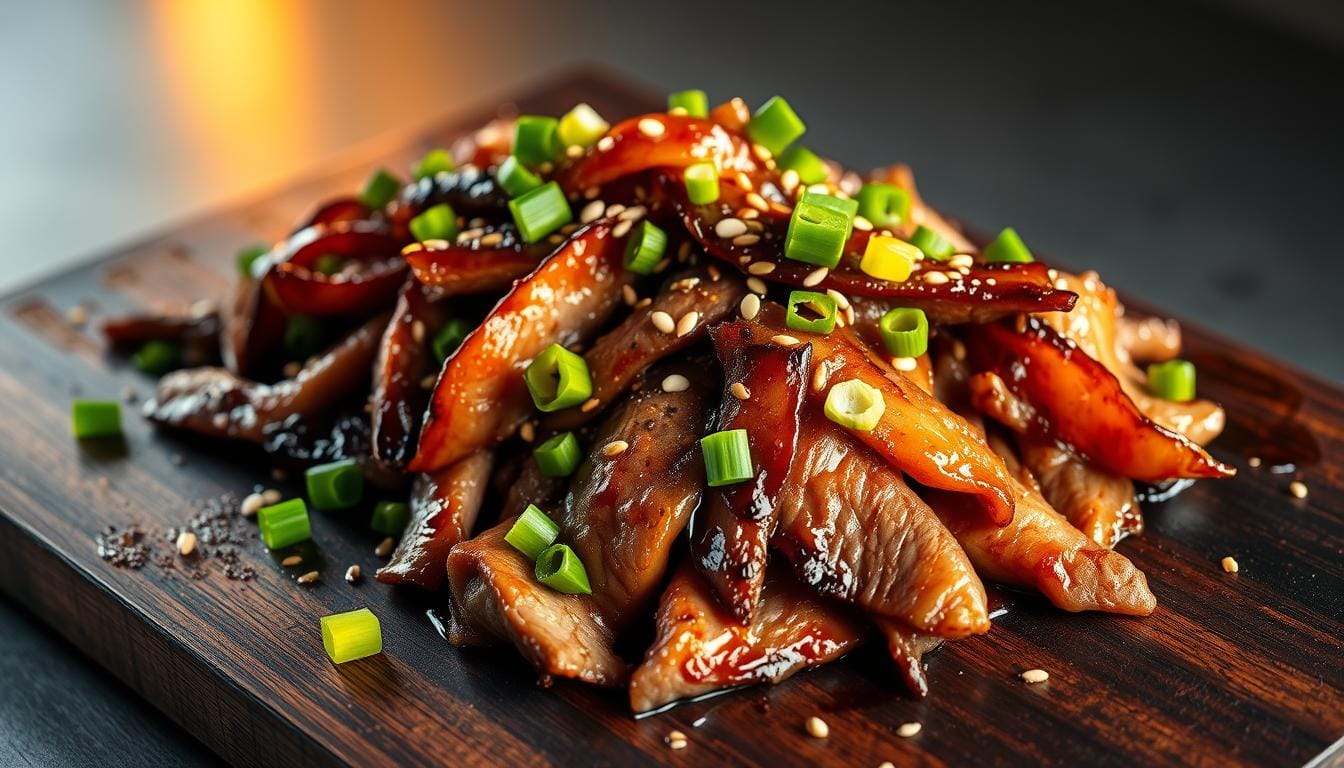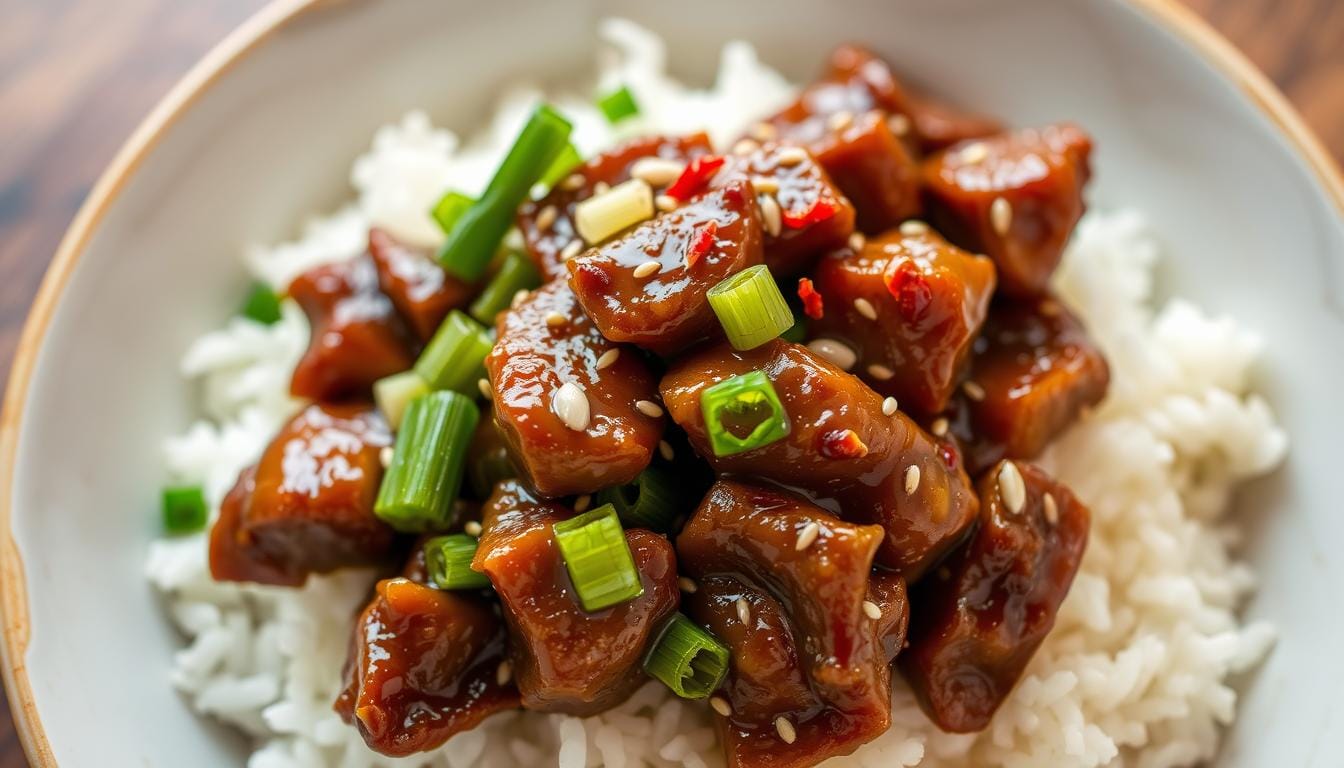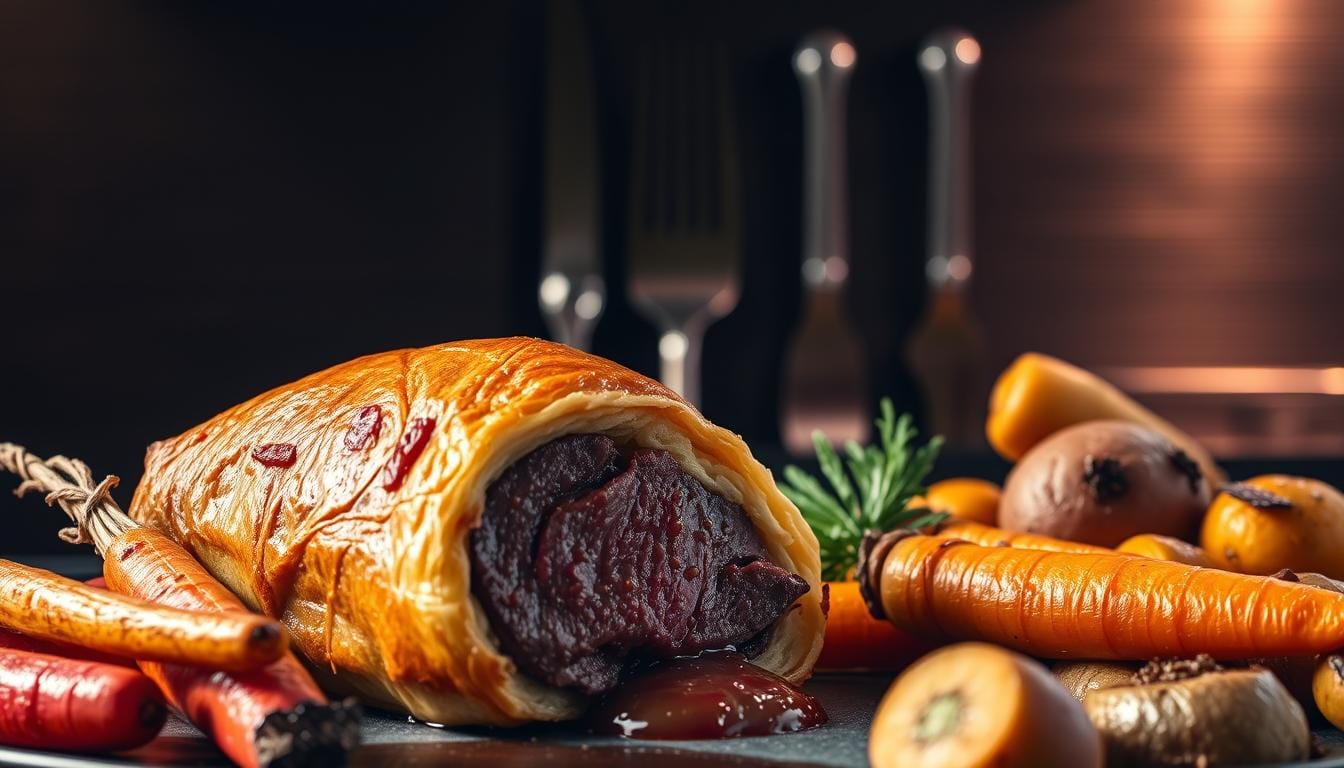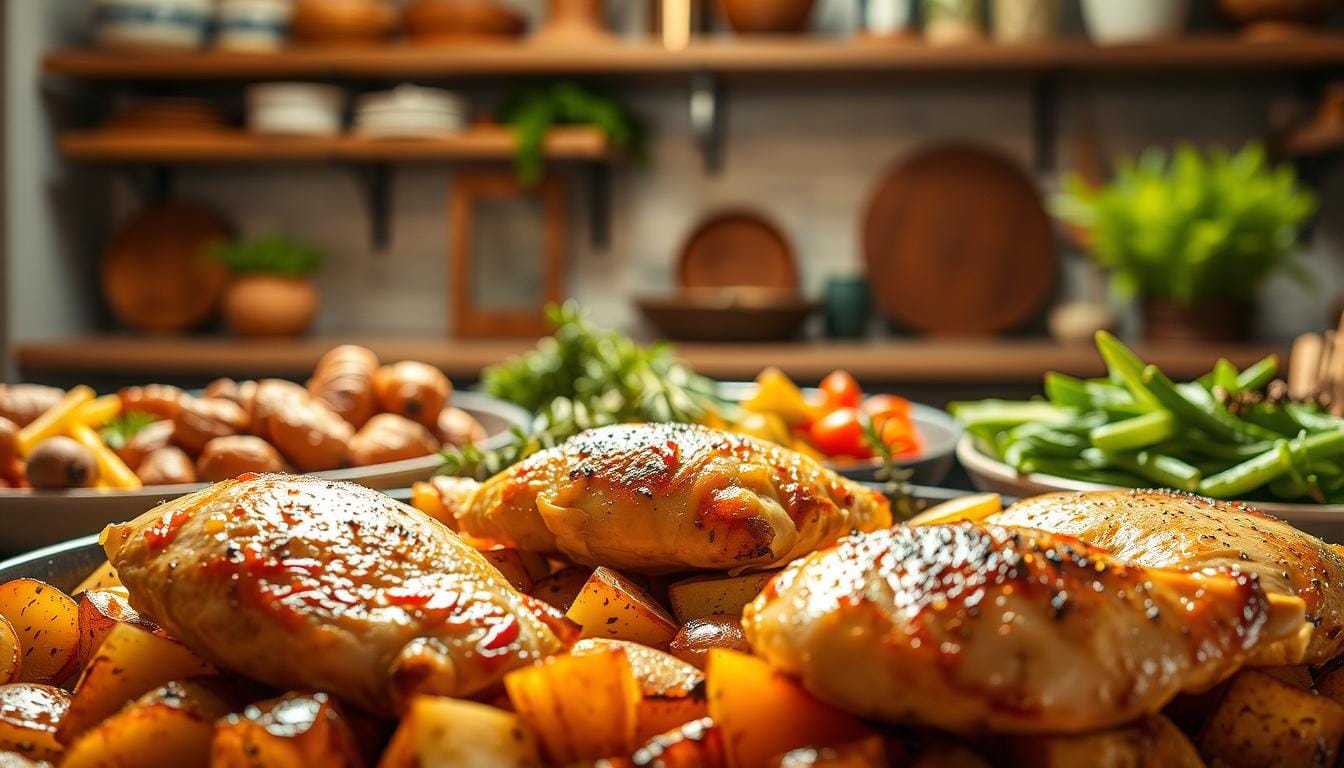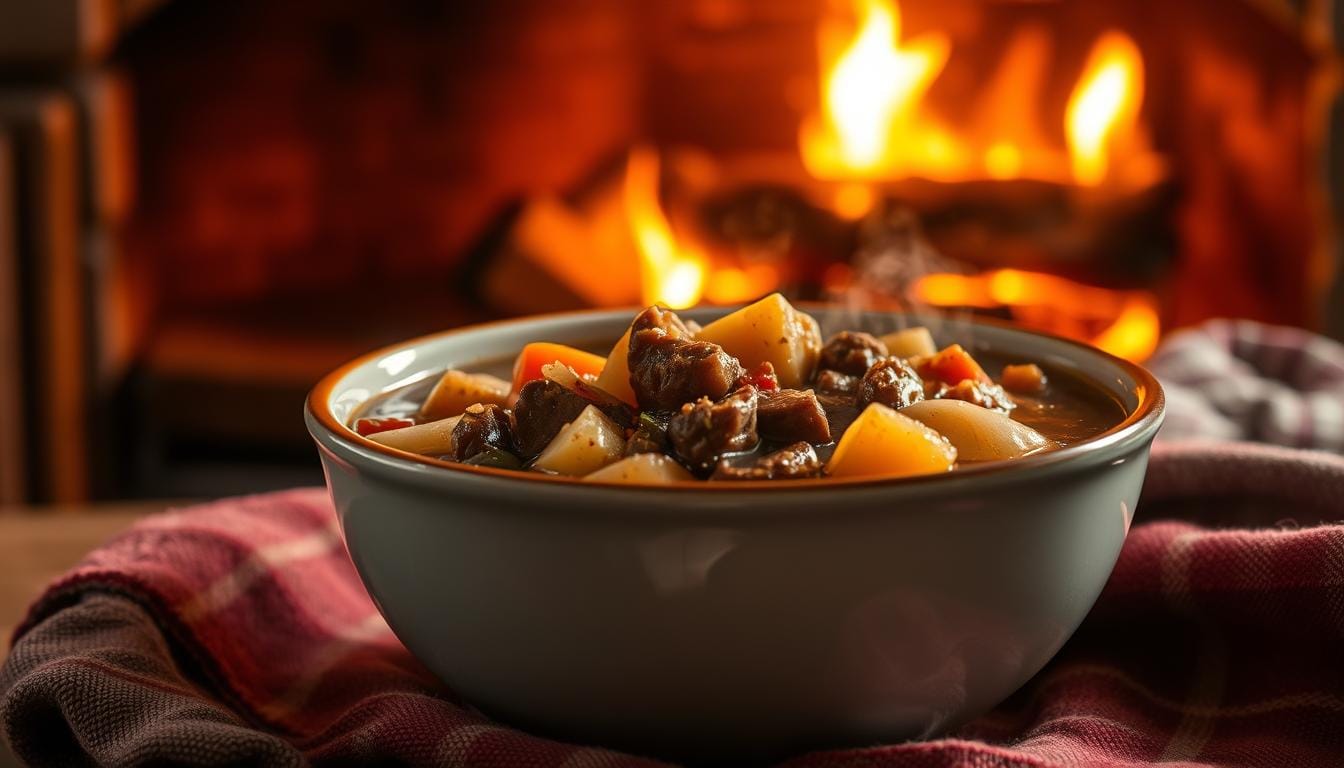Easy Korean Beef Recipe Perfect for Weeknight Dinners
Table of Contents
Easy Korean Beef Recipe
After a long day, you don’t want a hard dinner. This amazing Korean beef recipe is here to help. Imagine having a tasty, restaurant-quality meal ready in just 30 minutes.
This Korean beef recipe is perfect for busy cooks. It’s quick, with less than 20 minutes of prep and cooking. You’ll make a delicious dish that brings Korean flavors to your table. The best part? No long marinating needed!
With just 1 pound of lean ground beef, you’ll make a flavorful meal for six. The secret is the mix of soy sauce, brown sugar, and garlic. It makes the beef tender and the sauce irresistible.
Whether you’re new to Korean food or a pro, this recipe is a quick, healthy, and delicious dinner option. Your family will want more before you can even say it’s ready!
Introduction to Korean Beef Dishes
Korean cuisine is a world of flavors that turns simple beef into amazing dishes. The art of making korean bulgogi and beef galbi is a deep tradition. It’s more than just cooking meat.
Korean beef dishes are known for their unique flavors. They mix sweet, savory, and spicy tastes. These dishes are not just food; they show the culture’s culinary skill.
What Makes Korean Beef Unique?
Korean beef cooking is special because of a few things:
- Intricate marinating techniques
- Precise ingredient combinations
- Delicate balance of flavor intensities
- Use of traditional seasonings
“Korean beef is not just a meal, it’s a sensory journey through generations of culinary tradition.”
Popular Cuts of Beef Used in Korean Cuisine
Each cut of beef adds its own texture and taste to korean bulgogi and beef galbi. Knowing these cuts helps you make real Korean dishes at home.
| Beef Cut | Typical Use | Flavor Profile |
|---|---|---|
| Sirloin | Bulgogi | Tender, lean |
| Short Ribs | Galbi | Rich, marbled |
| Ribeye | Premium dishes | Extremely tender |
Choosing the right cut makes your korean beef truly special. It ensures a delicious and authentic meal.
Essential Ingredients for Korean Beef Recipe
To make a real Korean barbecue recipe, you need to pick the right ingredients. These ingredients bring out the deep, rich flavors of Korean food. Start your journey to a perfect Korean beef dish by knowing the key ingredients.
Beef Selection: Choosing the Right Cut
Choosing the right beef cut is key for a good kalbi marinade. For this recipe, use ground beef with 93% lean content. This low-fat beef is both tasty and healthy. Here are some beef options for your Korean dish:
- Ground beef (93/7 lean)
- Lean ground turkey
- Ground pork
- Crumbled tofu
Key Condiments and Marinades
A good kalbi marinade turns regular beef into a special Korean dish. You’ll need these key ingredients:
| Ingredient | Quantity |
|---|---|
| Soy sauce | 1/4 cup |
| Light brown sugar | 2 teaspoons |
| Sesame oil | 1 teaspoon |
| Gochujang sauce | 2 tablespoons |
| Crushed red pepper flakes | 1/2 teaspoon |
Fresh Produce to Enhance Flavors
Add fresh, vibrant ingredients to your Korean barbecue recipe. These ingredients add flavor and nutrition:
- Sauteed mushrooms
- Bok choy
- Matchstick carrots
- Edamame
- Green onions
Pro tip: Always use fresh ingredients to maximize the authentic taste of your Korean beef dish!
By choosing your ingredients wisely, you’ll make a Korean beef recipe that’s both tasty and healthy.
Step-by-Step Preparation Guide
Preparing a marinated beef recipe from Korea needs care and precision. Korean cooking is all about detail, turning simple things into amazing meals. Let’s go through the steps together.
Preparing the Perfect Marinade
To make a great Korean beef marinade, mix key ingredients. You want sweet, savory, and spicy flavors. Here’s what you need:
- 2 tablespoons low-sodium soy sauce
- 2 tablespoons honey
- 1 tablespoon sesame oil
- 3 minced garlic cloves
- 2 tablespoons minced ginger
- ¼ teaspoon red pepper flakes
Marinating Techniques for Maximum Flavor
Marinating is key in Korean cooking for deep flavors. Put your beef in a container with the marinade and chill for at least 30 minutes. Longer marinating means more flavor.
Expert Slicing Techniques
Right slicing makes beef tender and tasty. Cut thin slices, about ¼ inch, against the grain. This breaks down the meat, making it tender.
“The secret to great Korean beef is in the preparation and precision of your cuts.” – Korean Culinary Expert
| Preparation Step | Time Required | Key Technique |
|---|---|---|
| Marinade Preparation | 5 minutes | Whisking ingredients thoroughly |
| Marinating Beef | 30-60 minutes | Refrigerate in sealed container |
| Beef Slicing | 3-5 minutes | Cut against the grain, ¼ inch thick |
Learning these steps will make your marinated beef recipe shine. It brings real Korean flavors to your dinner.
Cooking Methods for Korean Beef
Trying out different cooking methods can make your Korean barbecue recipe stand out. Knowing the best way to cook can lead to delicious grilled Korean beef. This beef will have the real flavors and textures of Korea.
Stir-Frying: The Traditional Approach
Stir-frying is the most traditional way to cook Korean beef. It cooks the meat quickly, keeping it tender. It also brings out deep, rich flavors. Begin by heating a wok or large skillet over high heat. Add a tablespoon of sesame oil.
- Slice beef against the grain for maximum tenderness
- Cook in small batches to ensure even browning
- Stir-fry for 2-3 minutes until meat is just cooked
Alternative Cooking Techniques
Grilling is a great alternative for Korean barbecue. Charcoal grilling gives the best smoky taste, loved by Korean chefs.
| Cooking Method | Cooking Time | Flavor Profile |
|---|---|---|
| Grilling | 3-4 minutes per side | Smoky, charred exterior |
| Pan-searing | 2-3 minutes per side | Crispy exterior, tender interior |
Using a Slow Cooker for Korean Beef
For those who are always on the go, a slow cooker is perfect. It cooks Korean beef slowly, making it tender. This method is great for tougher cuts of meat.
“The secret to great Korean beef is patience and the right cooking technique.” – Korean Culinary Expert
No matter the method, remember to slice the beef thinly and marinate it well. This is the key to authentic Korean beef flavors.
Suggested Serving Options
Turning your Korean beef recipe into a great meal needs creativity and a grasp of Korean cuisine. The right mix can make your dish go from simple to amazing. It makes dinner both healthy and fun.
Pairing with Rice and Vegetables
Your Korean beef is best served over steamed white rice. For a healthier choice, try these:
- Cauliflower rice for a low-carb option
- Brown rice for extra nutrition
- Quinoa for a protein-rich base
Creating a Korean Beef Bowl
Korean beef bowls are a full meal in one. Arrange your ingredients for the best taste and look:
- Begin with your base (rice or alternative)
- Add your seasoned Korean beef
- Top with fresh veggies like shredded carrots, green onions, or steamed broccoli
- Finish with sesame seeds
Accompaniments: Side Dishes to Serve
Boost your Korean beef with traditional sides that match its rich flavors:
- Kimchi for a tangy twist
- Pickled cucumbers
- Light cucumber salad
- Steamed edamame
Pro tip: A splash of Sriracha mayo can add an extra layer of excitement to your Korean beef bowl!
With these tips, you’ll turn a simple Korean beef recipe into a top-notch meal. It celebrates the rich flavors of Korean cuisine.
Tips for Making the Perfect Korean Beef
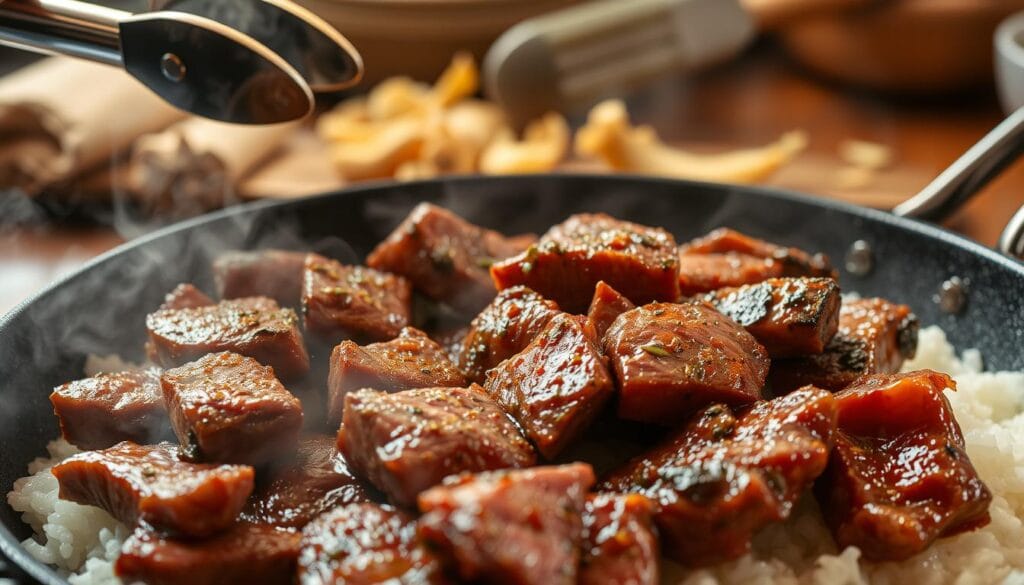
To make amazing spicy Korean beef, you need to know a few tricks. Your Korean barbecue recipe can go from good to great with expert tips. These tips will boost the flavor and texture.
Balancing Flavor Profiles
The key to great Korean beef is finding the right mix of sweet, savory, and spicy. Learning how to mix these flavors will make your dish unforgettable.
- Start with high-quality beef cuts like ribeye or flank steak
- Use a balanced marinade with soy sauce, sugar, and sesame oil
- Include gochugaru (Korean red pepper flakes) for authentic heat
Customizing Spice Levels
Everyone likes different levels of heat in their spicy Korean beef. Here’s how to adjust it:
- Start with 1/2 teaspoon of crushed red pepper flakes
- Slowly add more to get more heat
- Use gochujang (Korean chili paste) to control the spice
“The beauty of Korean barbecue is its versatility in flavor and heat!” – Korean Cuisine Expert
Cooking Techniques for Tender Beef
To keep your beef tender and tasty, follow these tips:
- Chill meat in freezer for 15-30 minutes before slicing
- Slice beef against the grain at a 45-degree angle
- Cook in batches to prevent overcrowding the pan
- Aim for 4-5 minutes of cooking until beef is perfectly browned
With these tips, you’ll be able to make delicious spicy Korean beef at home.
Storage and Meal Prep Advice
Preparing a delicious Korean beef recipe doesn’t stop after cooking. Learning how to store and reheat your marinated beef is key. This way, you can enjoy meals all week while keeping the flavor and texture perfect.
Refrigerator Storage Strategies
Leftover Korean beef can be stored safely in an airtight container in the fridge. It’s best to keep it for 3-4 days. This ensures your meal prep stays tasty and fresh.
- Use sealed glass or plastic containers
- Keep refrigerated at 40°F or below
- Separate meat from rice and vegetables to maintain freshness
Freezing Your Korean Beef Meal Prep
Freezing is a great way to keep your marinated beef fresh longer. When stored right, your Korean beef can last up to 2-3 months in the freezer.
- Use freezer-safe containers
- Portion meals individually for easier thawing
- Label containers with date of preparation
Reheating Tips for Maximum Flavor
Reheating your Korean beef needs care to keep it juicy and flavorful. Follow these steps to make sure your meal tastes as good as when it was first made.
- Microwave at 50% power
- Cover the dish to retain moisture
- Heat in 30-second intervals, stirring between
- Add a tablespoon of water if needed to prevent drying
Pro tip: Always reheat your Korean beef slowly to maintain its tender texture and prevent overcooking.
By using these storage and reheating tips, you can turn your Korean beef recipe into easy, tasty meal prep. It saves time and pleases your taste buds.
Nutritional Benefits of Korean Beef
Exploring Korean cuisine means looking at the nutritional value of a korean beef recipe. Your favorite beef dish is not just tasty—it’s full of nutrients that help your health.
Your korean beef recipe is a nutritional powerhouse. It’s more than just protein. Let’s look at the main health benefits:
High-Quality Protein Source
Beef is a top-notch protein source. It helps keep muscles strong and growing. A three-ounce serving has about 33 grams of protein, making it great for healthy meals.
- 90% lean ground beef reduces fat intake
- Supports muscle growth and repair
- Provides essential amino acids
Vitamins and Minerals Found in Ingredients
The ingredients in your korean beef recipe add to your health:
| Nutrient | Benefit |
|---|---|
| Choline | Supports brain health (80 mg per serving) |
| Zinc | Enhances immune function |
| B Vitamins | Promotes energy metabolism |
Adding garlic, ginger, and sesame oil makes your meal not just tasty. It also boosts your intake of antioxidants and anti-inflammatory compounds.
Nutrition isn’t just about calories; it’s about consuming whole, nutrient-rich foods that support your body’s needs.
Your korean beef recipe is a balanced way to eat. It shows that healthy meals can also be delicious.
Common Mistakes to Avoid
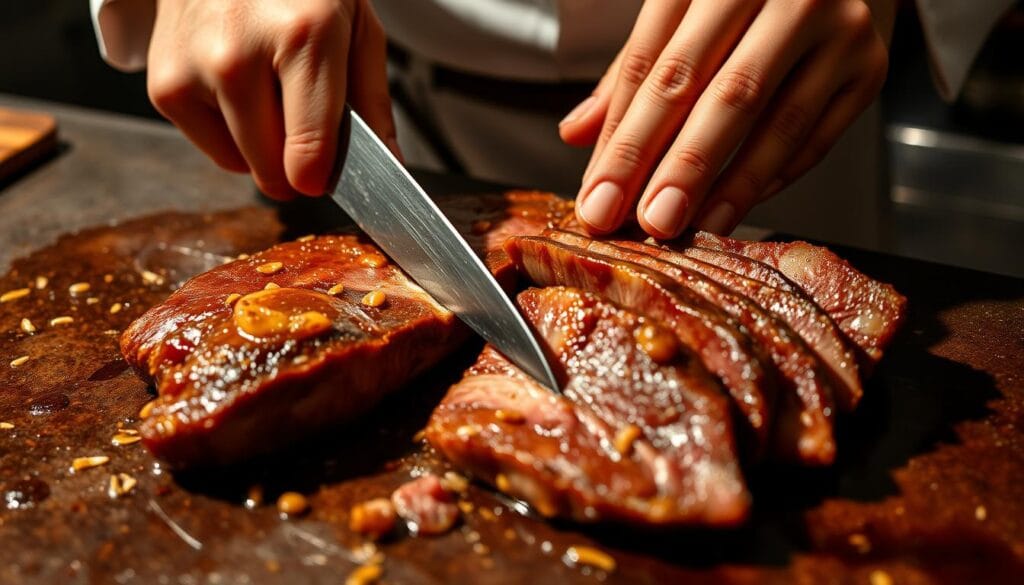
Making a tasty Korean barbecue recipe needs careful attention. Many home cooks make big mistakes that ruin a dish. These errors can turn a great meal into a bad one.
Knowing the common mistakes helps make your korean bulgogi better. Let’s look at the main errors that can mess up your Korean beef.
Avoiding Beef Cooking Disasters
Overcooking is the biggest problem for tender korean bulgogi. About 70% of home cooks struggle with meat texture because of bad cooking methods.
- Sear meat quickly at high heat
- Cook in a single layer to prevent steaming
- Aim for 3-4 minutes total cooking time
The Critical Marinating Process
Not marinating can make your Korean barbecue taste bland. Marinating is key for deep, real flavors.
| Marinating Mistake | Potential Consequence |
|---|---|
| No marination | Bland, uninteresting meat |
| Too short marination | Minimal flavor penetration |
| Overmarinating | Meat texture becomes mushy |
Selecting the Right Beef Cut
Pro tip: Not all beef cuts are the same. Top sirloin is best for korean bulgogi. Bottom sirloin can make the meat tough and chewy.
“The secret to great Korean beef is in the cut and the care.” – Korean Culinary Expert
By avoiding these mistakes, your Korean barbecue will be unforgettable. Remember, practice, patience, and detail are your best friends in the kitchen.
Vegan and Vegetarian Alternatives
Korean cuisine is perfect for those who love plant-based cooking. You can turn your favorite Korean barbecue recipe into a tasty vegan dish. Just use different ingredients and cooking methods.
Looking for plant-based proteins to replace beef in Korean dishes? There are many great options that bring out the true Korean flavors. Here are some:
- Shiitake mushrooms with their meaty texture
- Extra-firm tofu for protein-rich meals
- Soy curls mimicking beef’s consistency
- Portobello mushrooms for hearty dishes
Creating a Tofu Korean Recipe
Make your Korean barbecue recipe shine with tofu as the main star. The secret is a tasty marinade that makes plant-based proteins taste like the real thing.
“Vegan Korean cuisine proves that plant-based cooking can be just as delicious and satisfying as traditional meat-based recipes.”
Essential Vegan Ingredient Substitutions
For a great vegan Korean dish, you need to swap out some ingredients:
- Replace traditional soy sauce with low-sodium tamari
- Use coconut sugar instead of refined sugars
- Choose natural sweeteners like pure maple syrup
- Select gluten-free alternatives when possible
Vegan Korean dishes are not only tasty but also good for you. They have lots of protein and less cholesterol. Each serving has just 151 calories and 8.4g of protein.
Cooking Tips for Vegan Korean Dishes
Get better at making vegan Korean food by focusing on flavor. Start by sautéing onions until they’re soft and golden. Add fresh garlic and ginger, and play with spice levels using red pepper flakes.
Pro tip: Marinating your plant-based proteins for at least 30 minutes helps develop rich, authentic Korean flavors.
Experiencing Authentic Korean Flavors
Korean cuisine is more than just cooking. Beef galbi is a cultural experience that connects us to Korea’s culinary past.
Korean cuisine is full of regional flavors that make each dish special. Different parts of Korea use local ingredients and cooking methods to create unique tastes.
Regional Beef Dish Variations
- Jeju Island: Known for tender, grass-fed beef with unique marinades
- Seoul: Urban-style beef dishes with complex layered flavors
- Gyeongsang Province: Robust and hearty beef preparations
- Jeolla Province: Delicate beef recipes with subtle seasoning
Traditional Korean Eating Practices
Learning about Korean cuisine is more than just recipes. It’s about communal dining and sharing. Side dishes, or banchan, are key to a balanced meal.
“Food is not just sustenance in Korean culture – it’s a way of connecting people.” – Korean Culinary Expert
When you make beef galbi, you’re part of a tradition that values flavor, community, and skill.
Conclusion: Enjoying Your Korean Beef
Your Korean beef recipe is a fun trip into Korean cuisine. It only takes 20 minutes to prepare, making a meal for four with great taste. It’s also healthy, with 27 grams of protein and just 251 calories per serving.
Try new things with your Korean beef. You can serve it over rice, in lettuce cups, or with fresh veggies. It’s all about mixing traditional flavors with your own twist, making it a true Korean meal.
Encouraging Culinary Creativity
Feel free to change spices, swap out ingredients, or try new ways to serve it. Your Korean beef is a blank slate for your creativity. The mix of sesame oil, soy sauce, and brown sugar gives it a strong base that you can make your own.
Sharing with Family and Friends
Cooking is best when you share it with others. Your Korean beef is great for family dinners or get-togethers. Get your friends involved in cooking to make it a fun, shared experience. Every bite is a story of tradition, taste, and connection.
FAQ
What is the best cut of beef for Korean beef recipes?
Sirloin or rib-eye are great for bulgogi. They’re tender and marinate well. For galbi, use flanken-style short ribs for that authentic Korean flavor.
How long should I marinate the beef?
Marinate for 2-4 hours or overnight for the best flavor. This lets soy sauce, garlic, and sesame oil soak into the meat.
Can I make Korean beef without a grill?
Yes! You can stir-fry, pan-sear, or slow cook Korean beef. Each method gives a unique taste and texture.
Is Korean beef spicy?
It can be mild or spicy, depending on the gochugaru or gochujang used. Adjust the spice to your liking.
How do I get tender beef when cooking Korean-style?
Slice thinly against the grain, marinate well, and cook quickly. Stir-frying is best to keep the meat tender.
What are traditional side dishes to serve with Korean beef?
Serve with steamed rice, kimchi, pickled veggies, cucumber salad, and banchan. These sides balance the beef’s rich flavors.
Can I make a vegetarian version of Korean beef?
Yes! Use tofu, seitan, or mushrooms and the same marinade. These options soak up Korean flavors well, making a tasty vegetarian dish.

